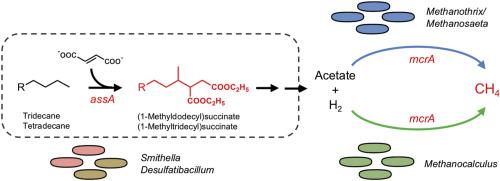当前位置:
X-MOL 学术
›
Int. Biodeterior. Biodegrad.
›
论文详情
Our official English website, www.x-mol.net, welcomes your
feedback! (Note: you will need to create a separate account there.)
Methanogenic biodegradation of C13 and C14 n-alkanes activated by addition to fumarate
International Biodeterioration & Biodegradation ( IF 4.1 ) Pub Date : 2020-09-01 , DOI: 10.1016/j.ibiod.2020.104994 Jia-Heng Ji , Yi-Fan Liu , Lei Zhou , Muhammad Irfan , Serge Maurice Mbadinga , Pan Pan , Jing Chen , Jin-Feng Liu , Shi-Zhong Yang , Wolfgang Sand , Ji-Dong Gu , Bo-Zhong Mu
International Biodeterioration & Biodegradation ( IF 4.1 ) Pub Date : 2020-09-01 , DOI: 10.1016/j.ibiod.2020.104994 Jia-Heng Ji , Yi-Fan Liu , Lei Zhou , Muhammad Irfan , Serge Maurice Mbadinga , Pan Pan , Jing Chen , Jin-Feng Liu , Shi-Zhong Yang , Wolfgang Sand , Ji-Dong Gu , Bo-Zhong Mu

|
Abstract n-Alkanes comprise a substantial proportion of crude oil; however, their degradation mechanism under methanogenic conditions is still unclear. Here, we investigated the initial activation mechanism of biodegradation of n-tridecane and n-tetradecane by methanogenic cultures enriched from a low-temperature oilfield production water. Methane accumulated in alkane-degrading enrichment cultures during the whole incubation period of 364 days, demonstrating that alkanes were actively degraded. Putative metabolites consistent with succinylated n-tridecane and n-tetradecane were detected, together with alkylsuccinate synthase-like genes, suggesting that alkanes were initially activated upon the addition of fumarate. Smithella and Desulfatibacillum in conjunction with hydrogenotrophic and acetoclastic methanogens were proposed to be important alkane degraders under methanogenic conditions. The results of this work added evidence that fumarate addition is a key activation mechanism in methanogenic alkane degradation.
中文翻译:

添加富马酸盐活化的 C13 和 C14 正构烷烃的产甲烷生物降解
摘要 正构烷烃占原油的很大比例;然而,它们在产甲烷条件下的降解机制仍不清楚。在这里,我们研究了从低温油田生产水中富集的产甲烷培养物对正十三烷和正十四烷进行生物降解的初始活化机制。在 364 天的整个潜伏期内,甲烷在烷烃降解富集培养物中积累,表明烷烃被积极降解。检测到与琥珀酰化正十三烷和正十四烷一致的推定代谢物以及烷基琥珀酸合酶样基因,表明烷烃最初在加入富马酸盐后被激活。Smithella 和 Desulfatibacillum 与氢营养型和乙酰碎屑型产甲烷菌一起被认为是产甲烷条件下重要的烷烃降解剂。这项工作的结果增加了证据,即富马酸盐的添加是产甲烷烷烃降解的关键激活机制。
更新日期:2020-09-01
中文翻译:

添加富马酸盐活化的 C13 和 C14 正构烷烃的产甲烷生物降解
摘要 正构烷烃占原油的很大比例;然而,它们在产甲烷条件下的降解机制仍不清楚。在这里,我们研究了从低温油田生产水中富集的产甲烷培养物对正十三烷和正十四烷进行生物降解的初始活化机制。在 364 天的整个潜伏期内,甲烷在烷烃降解富集培养物中积累,表明烷烃被积极降解。检测到与琥珀酰化正十三烷和正十四烷一致的推定代谢物以及烷基琥珀酸合酶样基因,表明烷烃最初在加入富马酸盐后被激活。Smithella 和 Desulfatibacillum 与氢营养型和乙酰碎屑型产甲烷菌一起被认为是产甲烷条件下重要的烷烃降解剂。这项工作的结果增加了证据,即富马酸盐的添加是产甲烷烷烃降解的关键激活机制。











































 京公网安备 11010802027423号
京公网安备 11010802027423号